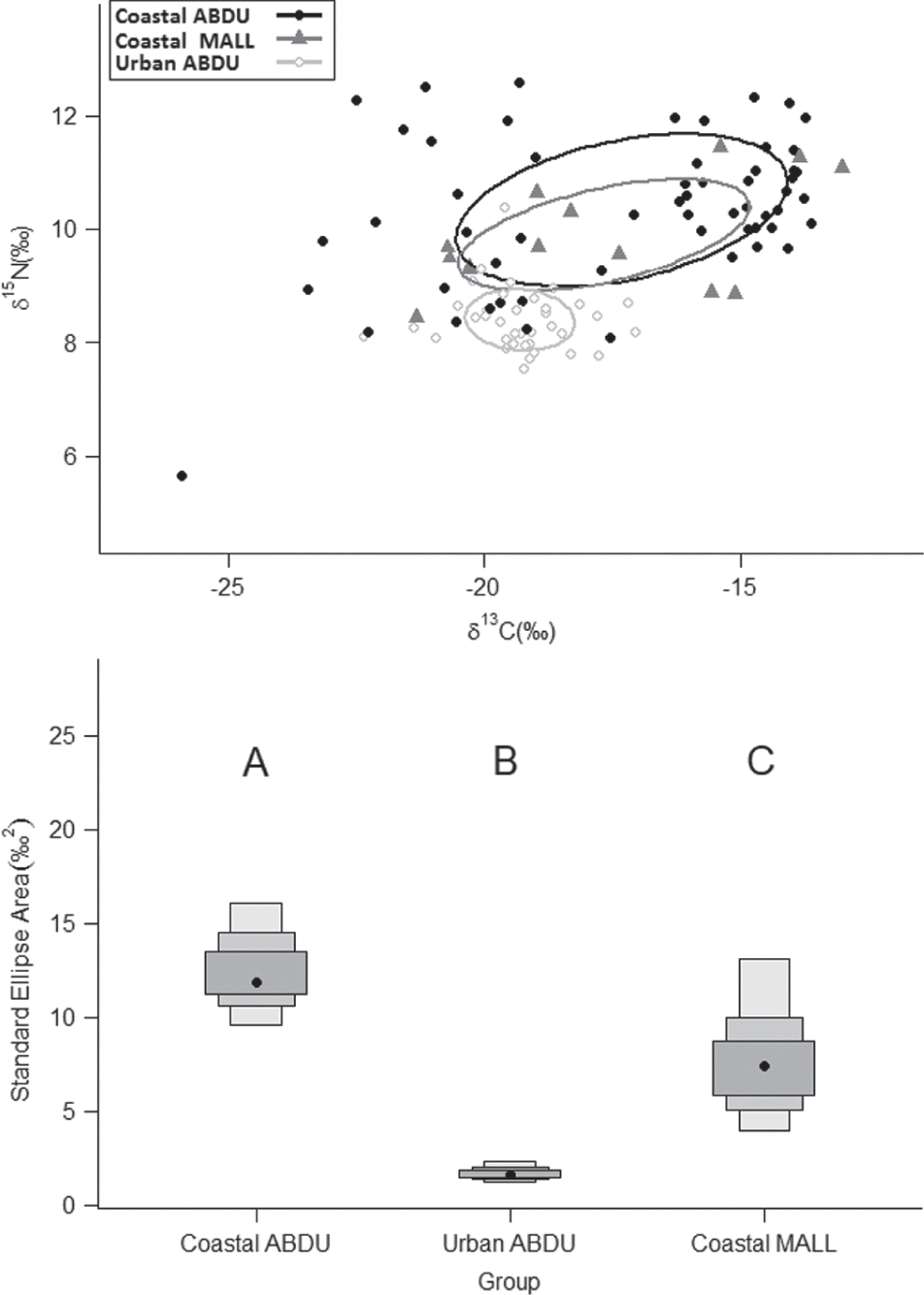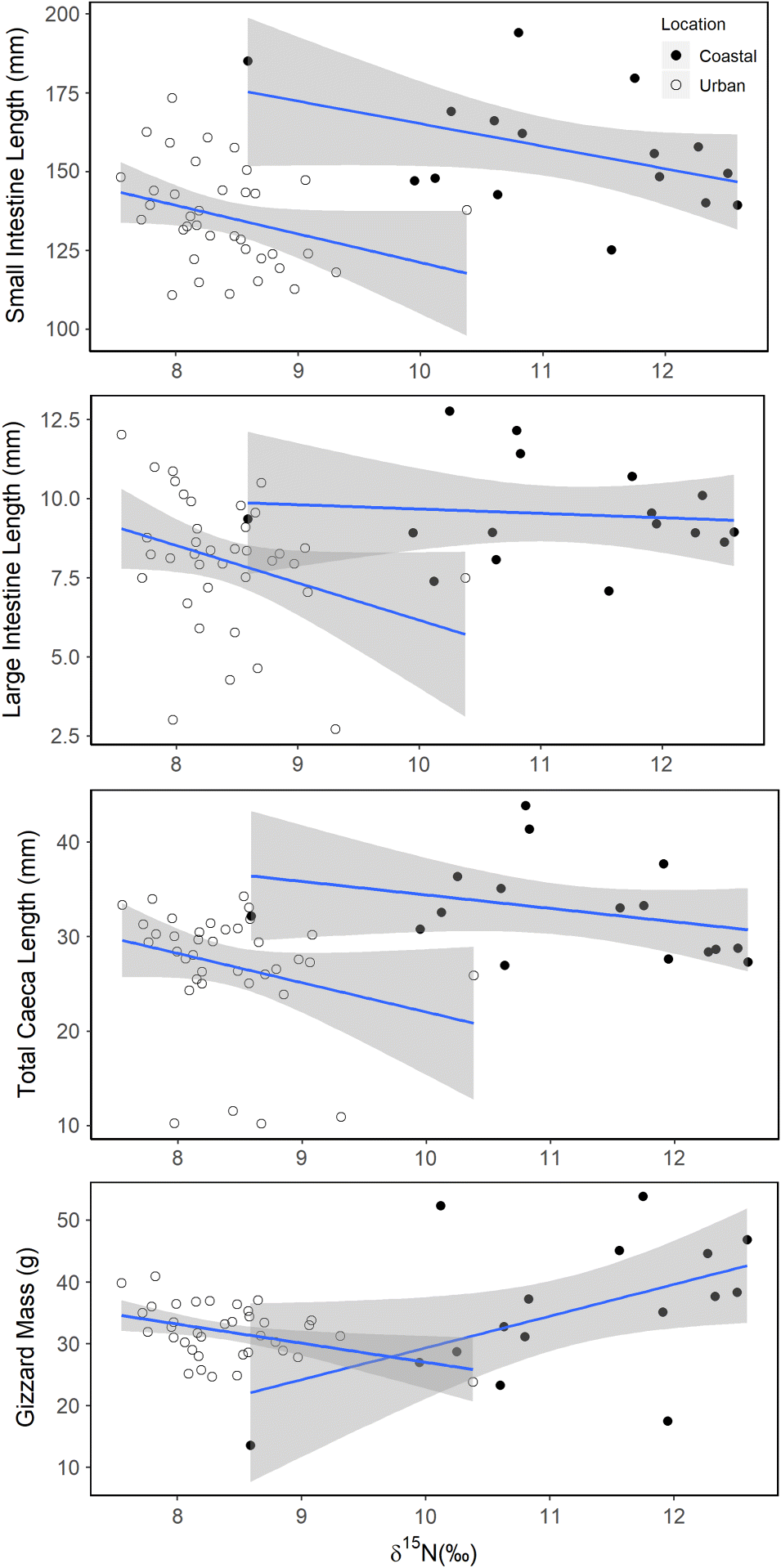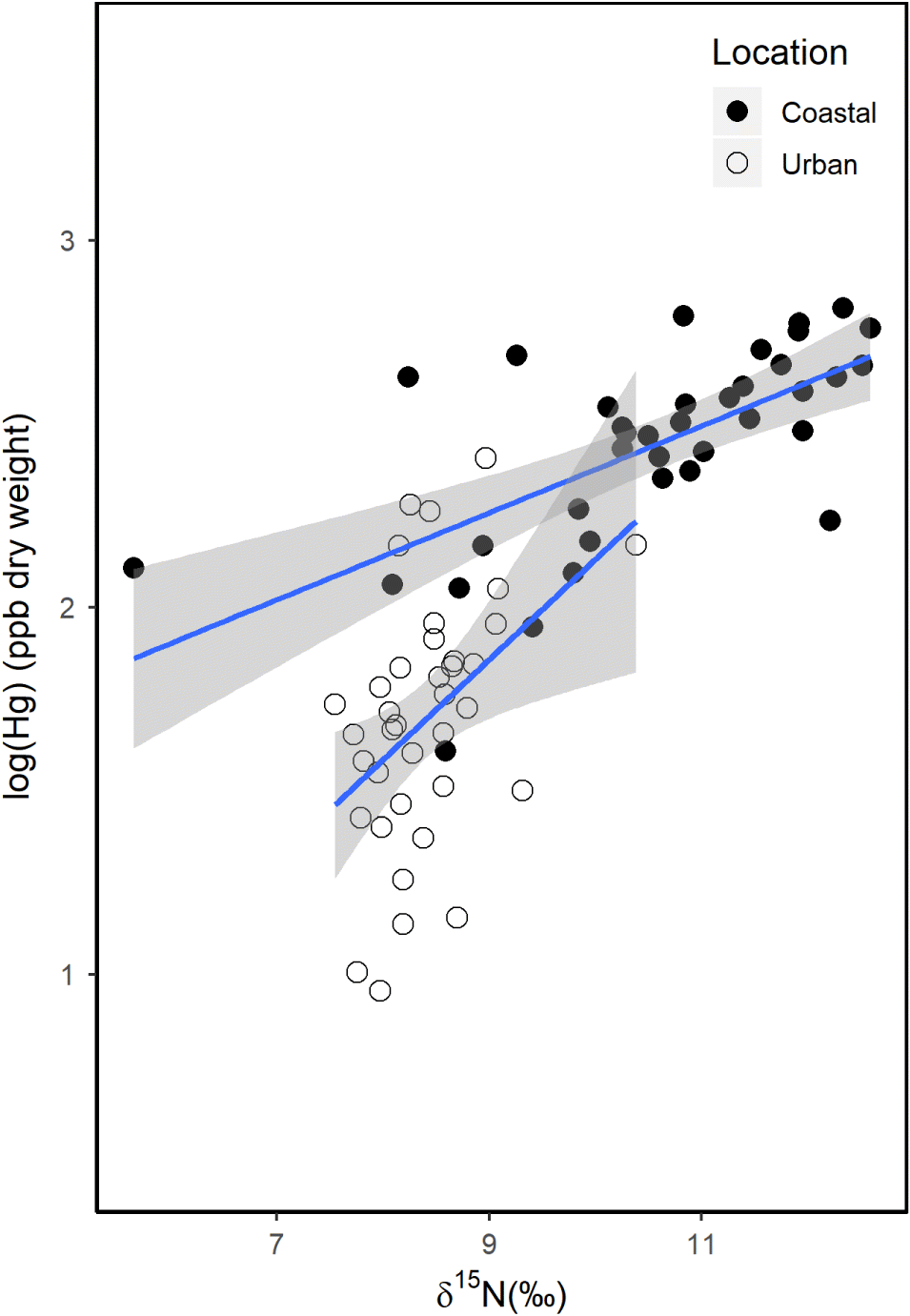Introduction
The concept of sympatric communities or populations exploiting different ecological niches to reduce competition is well-studied (
MacArthur 1958;
Toft 1980;
Webb et al. 2002). Ecological niches are often quantified using stable isotope analysis (typically of δ
13C and δ
15N), as stable isotopes can describe the biotic and abiotic characteristics of an organism’s environment such as diet, latitude, altitude, or its foraging habitat (i.e., marine or terrestrial; reviewed by
Newsome et al. 2007;
Hobson 2011). The resulting isotopic niche can be used to quantify differences in ecological niches within or among species (
Newsome et al. 2007;
Cloyed and Eason 2017;
Pratte et al. 2017). Varying isotopic niches have been related to intra- and interspecific differences in traits such as in morphology (e.g.,
Cloyed and Eason 2017) or foraging behaviour (e.g.,
Pratte et al. 2017) as species exploit their differing ecological niches.
Since long guts increase absorption time, they may increase the opportunity to absorb contaminants from the diet (
Kleinow and James 2001). In birds, contaminants are principally acquired through diet and thus are bioaccumulated from prey; birds that feed at high trophic levels generally have greater concentrations of contamination (
Wolfe et al. 1998;
Eulaers et al. 2013;
Sebastiano et al. 2017). Mercury (Hg) has long been studied because of its known toxicity on birds and its prevalence in the environment from natural and anthropogenic sources, and because it biomagnifies in food webs (
Wolfe et al. 1998;
Whitney and Cristol 2018). Consequently, the ecological niche occupied by a bird species should strongly influence the contaminants they acquire (e.g.,
Colas et al. 2014), so measuring isotopic niche width may be a method to explain intra- and interspecific differences in Hg concentrations, especially for species at similar trophic levels. However, to the best of our knowledge, this interaction has not been explicitly studied in birds.
American black ducks,
Anas rubripes (Brewster, 1902; hereafter black ducks) and mallards (
Anas platyrhynchos (Linnaeus, 1758)) provide an interesting model to study the concept of isotopic niche affecting intra- and interspecific traits and competition. Both species are hunted, and harvest regulations are set under an Adaptive Harvest Management (AHM) framework that considers the competitive exclusion hypothesis, stating that black duck population growth is limited by competition for habitat by mallards (
USFWS 2018). While mallards and black ducks do occupy similar habitats in eastern North America, there are studies that support (
Ankney et al. 1987;
Petrie et al. 2012) and reject (
Morton 1998;
Maisonneuve et al. 2006) the competitive exclusion hypothesis. More research on the competitive exclusion hypothesis is needed so it can be better incorporated into the black duck AHM framework, and understanding the winter ecology of black ducks is a priority identified by the Black Duck Joint Venture (
Black Duck Joint Venture Management Board 2014).
Atlantic Canada is the northern limit of the black duck wintering range, an area where wintering black ducks and breeding mallards have increased over the last four decades (
Robertson et al. 2017;
Sauer et al. 2017). Black ducks wintering in Atlantic Canada exploit different ecological niches, ranging from coastal saltmarshes to urban areas and parks (
McCorquodale and Knapton 2003;
English et al. 2017). The diets of coastal and urban black ducks are different with coastal black ducks consuming a variety of animal (mainly marine invertebrates) and plant matter, whereas urban black ducks mostly consume anthropogenic subsidies (e.g., corn and bread;
English et al. 2017). Sympatrically wintering mallards in coastal areas have diets consisting mostly of seeds and other vegetation and do not heavily forage on marine invertebrates (
Drilling et al. 2002;
English et al. 2017).
In this paper we extend the previous results of
English et al. (2017) and specifically examine the isotopic niches of black ducks and mallards wintering in coastal and urban areas of Atlantic Canada. Further, we relate isotopic signatures and breadth of isotopic niches, as determined by δ
13C and δ
15N, to differences in digestive tract morphologies and blood mercury (Hg) concentrations. We chose Hg as a biomarker because of its known prevalence in prey of black ducks in the Bay of Fundy (
English et al. 2015,
2017), and because only limited data on Hg concentrations in waterfowl have been reported in Atlantic Canada (see
Braune and Malone 2006;
Mallory et al. 2018). Hg bioaccumulation tends to be positively correlated with trophic level, notably in species that forage on invertebrate prey compared to plants (
Wolfe et al. 1998). Consequently, in conjunction with isotopes its use may allow corroborating or enhanced ability to distinguish dietary or ecological patterns between sympatric groups of birds. We expected the diverse diets of coastal black ducks would result in a wider isotopic niche, increased gut lengths, and higher blood Hg concentrations than urban black ducks. We did not manage to study urban mallards, but we expected the coastal mallards in our study to have values between coastal black ducks and urban black ducks.
Methods
Duck collection
Seventy-four American black ducks (38 males, 36 females) were collected for this study, with 37 collected opportunistically by hunters in coastal saltmarsh habitat of Nova Scotia and New Brunswick, Canada, from 26 November 2013 to 27 March 2014, and 37 collected and euthanized by cervical dislocation by Environment and Climate Change Canada employees in an urban freshwater pond in St. John’s, Newfoundland and Labrador, from 11 February 2014 to 15 April 2014. Thirteen mallards (six males, seven females) were collected opportunistically by hunters in coastal saltmarsh habitat of Nova Scotia from 30 January 2014 to 25 March 2014. All ducks were sent to Acadia University, where they were stored frozen at −18 °C.
The collection of black ducks and mallards for this project was pre-approved by Acadia University (Animal Care Permit No. 02-14) and Environment and Climate Change Canada (Scientific Permit No. ST2785).
Isotopic niche analysis
Blood samples were taken from the heart of each frozen carcass, and stored whole at −18 °C. Additional blood samples were collected during winter banding operations in 2015. Live-trapped ducks were caught in a pond in Grand Manan, New Brunswick, using a baited single-wire funnel trap, and in a coastal saltmarsh in Cole Harbour, Nova Scotia, using a cannon net. Prior to drawing blood, the wing surface was sterilized with 95% ethanol, and then approximately 50 μL of blood were drawn from the brachial vein using a capillary tube. The sampled ducks were released where they were caught, and blood samples were stored whole at −18 °C.
Whole blood samples were dried at 60 °C for 48 h, ground into a powder, and sent to the Stable Isotopes in Nature Laboratory (SINLAB, University of New Brunswick, Fredericton, New Brunswick, Canada) for analysis of isotopes of carbon and nitrogen. Samples were combusted in an elemental analyzer, and gases were sent to the isotope-ratio mass spectrometer using a continuous flow interface. Data are reported as differences in isotopic ratios, for which the units are parts per thousand (or per mil; ‰), compared with Pee Dee Belemnite, for carbon, and atmospheric nitrogen, for nitrogen, according to the following equation:
where δ
X is the isotope of interest (either δ
15N or δ
13C, in ‰),
R is the ratio of the abundance of the heavy to the light isotope (
15N/
14N or
13C/
12C), with
Rsample being the ratio within the sample, and
Rstd the ratio of heavy to light isotope within the international standard (
Hobson and Clark 1992).
Due to the known effects of species and location on isotopic ratios in blood of the birds in this study (
English et al. 2017), samples were divided in to three groups: coastal black ducks, urban black ducks, and coastal mallards. We used stable isotope Bayesian ellipses in R (SIBER) from the package “SIBER” and used a probabilistic method (
Jackson et al. 2011) to assess differences in isotopic niches among the three groups of ducks following the posterior draws of Bayesian-simulated standard ellipse areas (SEA
b; represented in ‰
2). The SEA
b values were compared among the three groups using Bayesian inference as described in
Jackson et al. (2011) (see
Pettitt-Wade et al. 2015;
Karlson et al. 2018 for examples). A Bayesian probability (
p) of SEA
b size difference >0.6 was considered to be significant (e.g.,
Pettitt-Wade et al. 2015). Layman’s metrics (
Layman et al. 2007) were used to further quantify the trophic structure of the three groups of birds.
Digestive tract analysis
All 74 black ducks and three of the 13 mallards were sent to the Avian Energetics Laboratory (Long Point, Ontario), where full carcass processing on thawed birds occurred using standardized methods (e.g.,
Reinecke et al. 1982;
Morton et al. 1990). To account for the effect of body size on digestive tract morphology, we extracted the first principal component (PC1) score of the correlation matrix of ln-transformed tarsus length, culmen length, head length, wing chord length, and plucked body length as an index of overall body size (as per
Kehoe et al. 1988;
Jónsson and Afton 2017). The PC1 accounted for 58% of the total original variance. Four gut measurements were examined: empty gizzard mass, small intestine length, large intestine length, and the combined length of the first and second segments of the caeca. Gut morphology data for each variable were regressed on PC1 to adjust them for body size (all regressions were positive and significant (
p < 0.05)). The residuals from each regression were used to calculate a new variable (
yi ) corrected for body size of each digestive tract component as per the following formula:
where
yobs is the observed measurement of the particular digestive tract component, and a and b are the values from the regression of each digestive tract component on PC1.
Waterfowl gut morphology is strongly affected by the annual cycle (
Drobney 1984;
Moorman et al. 1992) so we only examined ducks collected during overlapping time periods. We excluded 24 coastal ducks collected at the end of November 2013 due to a lack of urban ducks collected near this time. For the black ducks, we used a multivariate analysis of covariance (ANCOVA) to assess the effects of the factors “sex” and “location” (coastal vs. urban) on each digestive tract component, with date and isotope (either δ
15N or δ
13C) as the covariate. The gut morphology of the small number of mallards (
n = 3) was compared with black ducks using a separate multivariate analysis of variance (ANOVA).
Blood mercury analysis
From carcasses, we removed whole blood from clots in the heart, veins, or arteries. Samples (generally ∼1–2 g) were freeze-dried, homogenized to a powder using a clean mortar and pestle, and transferred to 1.5 mL Eppendorf tubes and frozen until analysis. We analyzed for total Hg at the Center for Analytical Research on the Environment at Acadia University. Samples were analyzed on a Nippon Instruments MA-3000 Mercury Analysis System using thermal pyrolysis, gold amalgamation preconcentration, and atomic absorption spectroscopy detection. Samples were not blank corrected, as mean blanks were −0.01 ± 0.01 ng/g (n = 11) with the method detection limit (MDL) calculated as 3× the standard deviation of the blanks (MDL = 0.03 ng/g). All samples were well above detection limits, and repeated measurements on seven samples yielded similar values (mean difference 1.8%). Internal quality control included analytical blanks and certified reference material (DORM-4, National Research Council of Canada). The mean recovery for the certified reference material (n = 13) was 95.4% ± 4.4% (SD) for total mercury (THg), so we did not recovery-correct THg values. THg concentrations are reported in parts per billion (ppb) dry weight.
Data on THg concentrations were not normally distributed (Shapiro–Wilk normality test:
W = 0.86;
p < 0.001), and were thus log
10-transformed. Only black ducks (
n = 74) were analysed using ANCOVA. For black ducks, the factorial effects of sex and habitat (coastal vs. urban), and the covariates of date of sampling and isotope (either δ
15N or δ
13C), on blood Hg concentrations were investigated using ANCOVA. The data from mallards (
n = 3) were compared with the coastal and urban black ducks using a separate ANOVA. All statistical analyses were performed using R version 3.4.3 (
R Development Core Team 2015).
Acknowledgements
This study would not have been possible without cooperation from landowners and hunters in Atlantic Canada. Specifically, we thank Randy Milton, Danny Sears, Lee Millet, and Gary Thurber for collecting the ducks used for full carcass analysis. Staff with Environment and Climate Change Canada in Mt. Pearl, Newfoundland and Labrador, collected the urban black ducks. We thank Cardy Hallett Saunders for preparing the blood samples for mercury analysis. Funding for this research came from the Black Duck Joint Venture, Environment and Climate Change Canada operating funds, and Acadia University. Finally, we are grateful for the insights provided by reviewers and editors on our manuscript.




